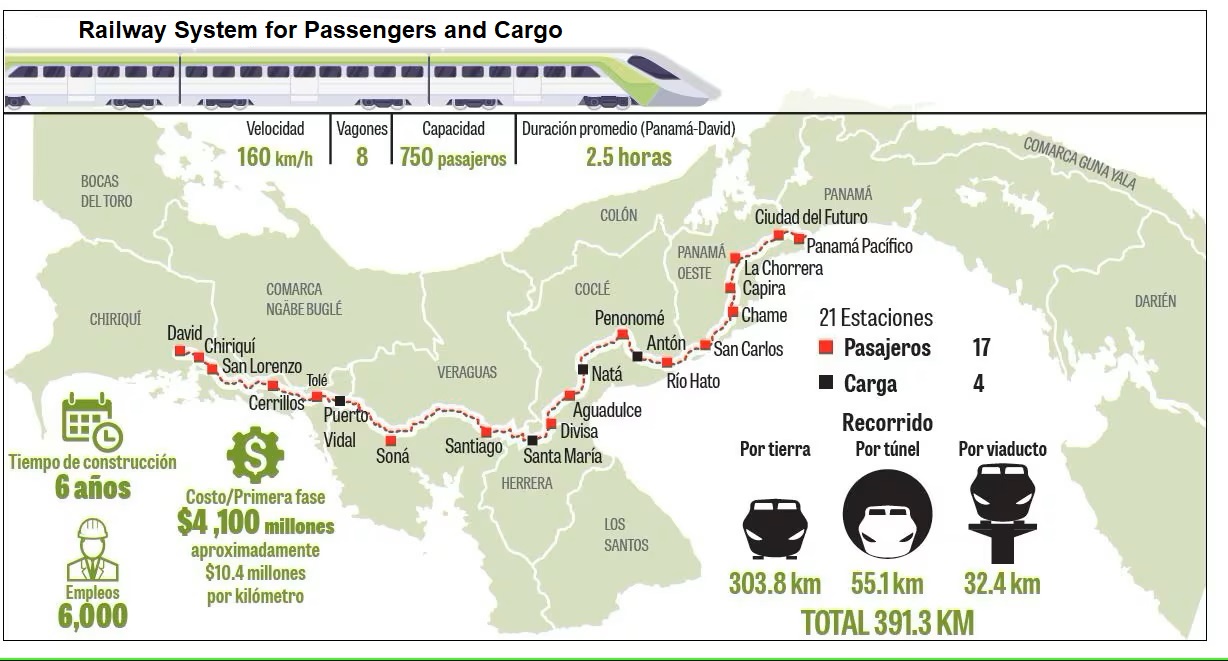Train From Panama to Chiriquí
According to the estimates presented at Cecomro, the estimated load on the train would be 40 thousand tons on long trips, but it is estimated that it could reach 2 million tons in the medium term. The train would help increase production, assuming lower costs and increase trade towards Central America. President-elect José Raúl Mulino, who was born in David, included the construction of a Panama-Chiriquí train as one of his campaign pillars. It is not yet known how much it will cost or how it will be financed. But business organizations and logistics experts anticipate that this is the project that the country needs to take advantage of its geographical position, which has not resulted in economic improvement for the provinces, precisely due to the lack of connectivity.
During a discussion organized by the Competitiveness Center of the Western Region (Cecomro), the Chiriquí-Panama Pro Train Committee was established, which will be in charge of promoting the plan so that the investment can be made, indicated Felipe Rodríguez, a member of the group. Rodríguez recalled that the first feasibility studies to build the railway section, which would be used to transport passengers and cargo, were carried out in 2018, in cooperation with the People's Republic of China. However, they have had partial access to the analysis, despite having requested the previous government (2014-2019) to “deliver it to us, and they never formally delivered all the studies that contemplate the participation of many national companies.” This is what is needed at the highest level. It is estimated that the speed of the train will be between 160 and 200 kilometers per hour. The alignment should link urban areas or areas with growth potential, in addition to connecting strategic loading points. The route that would be chosen must also accommodate the sites with the least environmental impact and must provide future connections for the branches.

“One of the things that the committee is going to start asking for, immediately, is access to all the studies that have already been done,” Rodríguez emphasized. The conversation with Rodríguez takes place after several members of Cecomro met in Chiriquí in person, to get in touch - through an online meeting - with Carlos Ernesto González De La Lastra, logistics advisor of the organization. González is convinced that a train to the producing province of Chiriquí, with several branches in the central provinces, will bring important economic and social benefits, and will overthrow the model of concentration of wealth in the capital city. "We have spent 10,000 million dollars on Metro lines, in Panama City, on the beach corridor and a bridge over the Canal... It is time to think about the integration of the entire country and take advantage of the advantages it offers our connectivity,” said González, in the face of possible criticism regarding the cost that the work could reach.
In economic terms, feasibility studies indicate that the cost of transporting a container from Chiriquí to Cristóbal (Colón) is about 1,500 dollars, while with the train this would represent 300 dollars, for the same route. “It means that there are 1,200 dollars left for the producer, who can use them to increase, double and multiply his production.” These new costs, according to González, will allow producers, instead of planning shipments in just one container, to agree and send 30 containers to their final destination, after achieving a lower logistical cost for that production. “There is nothing more to see than our neighbors in Puerto Rico; They export about 800,000 containers of refrigerated products a year and Panama 8,000, having all the connectivity we have. So, we must understand that the infrastructure of a train is absolutely essential to use advanced logistics and competitiveness in costs and speed of delivery,” González mentioned. In the middle of the conversation of about two hours, he said that the investments to be made, both in new infrastructure and in the improvement of existing ones, will only be possible through the active participation of the Government. However, the desired transformations cannot be carried out with the sole participation of the state sector.
“The participation of the private sector, as an operator and in turn as a dependent of services, is essential to guarantee the full use of the viability of these investments.” At the Cecomro meeting it was indicated that at least 5,000 employees would be needed in the construction period and regular workers in the operation period. From an economic point of view, González said that a table of multilateral entities must be achieved to be clear about the cost of the work and obtain long-term financing, with good financial conditions. He considered that one of the objectives should be to “invite multilaterals to finance the emblematic project of the new government in the long term, 30 or 40 years, with interest rates appropriate to the risk of Panama and with a grace period.” Panama must present a law that creates a railway company, I emphasize, because to obtain financing not only will the technical factors of construction have to be taken into account, but also everything related to the organizational structure, personnel training and financial controls. The typical financial model must take into account traffic and then the revenue from that traffic, operating subsidies, if any, operating costs based on the cost structure, capital investments, debt and their payment over time.
